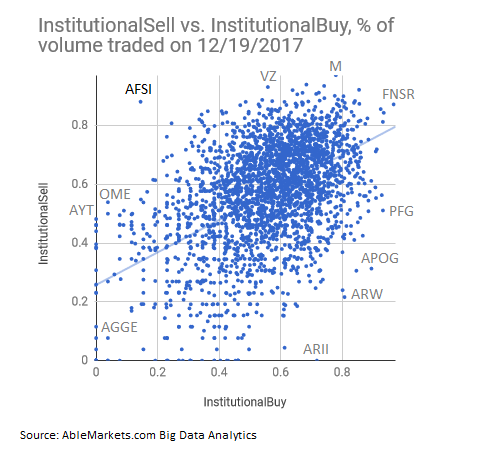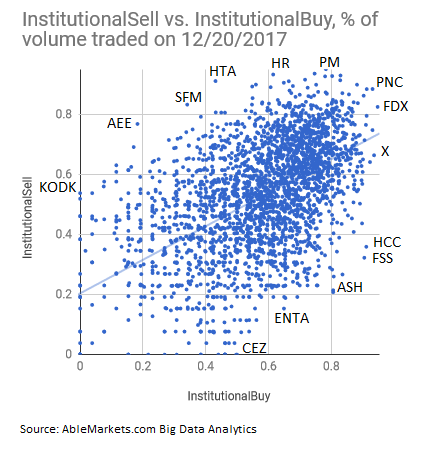The word on the street is that no indicator is more reliable about one’s beliefs of future economic conditions than one’s trading activity. It is fascinating to observe institutional investor activity immediately before and after the announcement that the U.S. Senate has conditionally passed the proposed new tax law in the context of understanding the thoughts and beliefs of institutional investors as expressed by their often billion-dollar investing decisions.
The new tax regime slashes corporate tax rates from 35% down to 21%, potentially resulting in direct increase in after-tax earnings, and, therefore, stock prices in 2018. From a cursory analysis, it would seem that the institutional investors would expect prices of all U.S. stocks to rise up in unison. Looking at detailed institutional activity analysis through the lens of AbleMarkets Big Data analytics, we observe a different, more nuanced story.
As discussed in Real-Time Risk: What Investors Should Know About Fintech, High-Frequency Tradinga and Flash Crashes (Wiley, 2017), AbleMarkets Institutional Activity participation index segments institutional activity within market data. Using Big Data analytics, AbleMarkets is able to detect the footprints left by institutional investors, traces invisible to the human eye but detectable by the sophisticated machine-learning algorithms. Figures 1 and 2 show the daily average participation of institutional investors in the buyer-initiated trades vs the seller-initiated trades in 2,700 equities, comprising most liquid Russell 3000 stocks and selected ETFs on the day before the new tax was passed (December 19, 2017, 6 PM) and the day after, December 20, 2017. The separation between the two days provides a natural event analysis setting for the institutional investors’ opinion on the future impact of the tax law.
On December 19, 2017, institutional investors dominated buying in 1,227 stocks out of 2,700 stocks, measured as names where the daily average proportion of institutional activity in buyer-initiated trades exceeded that in seller-initiated trades. On December 20, the number of stocks dominated by institutional buyers increased to 1,614. The absolute numbers of stocks institutions chose to buy as opposed to sell before the tax law passage shows an increase of believers in improved economic prospects. On December 19, institutional sellers dominated institutional buyers in SPY, an S&P 500 ETF, 58% to 36% by volume traded in buyer-initiated and seller-initiated trades, respectively. On December 20, however, institutional buyers outstripped institutional sellers in SPY 64% to 46%, signaling that institutional investors in general believe that the Tax Bill will stimulate the U.S. economy and propel the U.S. stock market to its new heights.
The dynamics of SPY and numbers of stocks which institutions chose to buy as opposed to sell on December 19 and 20 tell an incomplete story. A much more interesting and detailed picture comes to light when considering the issues that reversed institutional direction with the tax cut approval: from being dominated by institutional buyers to being sold off the next day after the passage of the tax plan and vice versa.
As Figure 1 shows, on December 19, institutions were hungry for names like PFG (Principal Financial Group, a retirement and asset manager and insurer), and were selling AYT (Barclays Global Emerging Markets Strategy Asia 8 Index) and AFSI (AmTrust Financial Services, a property and casualty insurance). In addition, among less prominent choices, institutions preferred to sell ZNGA (Zynga multimedia and graphics) and ZOES (Zoe’s Kitchen restaurants) and buy ZUMZ (Zumiez, a distributor of teen and sport clothing).
FIGURE 1. Average Institutional Activity in some of the U.S. most liquid equities and ETFs on December 19, 2017, before the Tax Bill was passed. Estimates by AbleMarkets Big Data Analytics.

The following day, on December 20, after the passing of the Tax Bill, institutions opted to buy CEZ (VictoryShares Emerging Mkt Vol Wtd ETF), ENTA (Enanta Pharmaceuticals) and FSS (Federal Signal Corporation, provider of solutions for local governments), and to sell HTA (Healthcare Trust of America, an investor and operator of medical facilities) and HR (Healthcare Realty Trust, similarly, an investor and operator of medical offices and outpatient facilities). In addition, institutions reversed their positions in AYT, AFSI, ZNGA, ZOES and ZUMZ.
FIGURE 2. Average Institutional Activity in some of the U.S. most liquid equities and ETFs on December 20, 2017, after the Tax Bill was passed. Estimates by AbleMarkets Big Data Analytics.

What accounted for these decisions? With the passage of the tax bill, the institutional investors appear to expect higher volatility in the Emerging Markets, as evident by their preference for CEZ (VictoryShares Emerging Mkt Vol Wtd ETF). In addition, the institutional investors are betting on the increased innovation in biotech and chemicals, by purchasing ENTA (Enanta Pharmaceuticals) and their competitors. Companies like FSS (Federal Signal Corporation, provider of solutions for local governments) are likely to be considered to be sought out by the municipalities in need of interpreting and implementing the new legislation. At the same time, the institutional investors have chalked off the prospects of medical office operators HTA (Healthcare Trust of America, an investor and operator of medical facilities) and HR (Healthcare Realty Trust, similarly, an investor and operator of medical offices and outpatient facilities), possibly due to the health insurance provisions in the Bill. Finally, institutional investors bet that the populace will embrace new consumer technology (ZNGA) and restaurants (ZOES).
Bottom line, institutional investors were well prepared for the passing of the Tax Bill legislation, and even anticipated it, judging by the pre-legislation sell-off of AYT (Barclays Global Emerging Markets Strategy Asia 8 Index), as Trump promised to return manufacturing from Asia with lower corporate taxes. Post-legislation sell-off of HTA (Healthcare Trust of America, an investor and operator of medical facilities) and HR (Healthcare Realty Trust, similarly, an investor and operator of medical offices and outpatient facilities) are the signs of clear institutional analysis and strategy in the healthcare center. Similarly, a pre- to post-legislation reversal in institutional appetite for the cyclical stocks such as ZNGA, ZOES and ZUMZ indicate detailed analysis of the potential outcomes, and not investing based on political preference or belief.